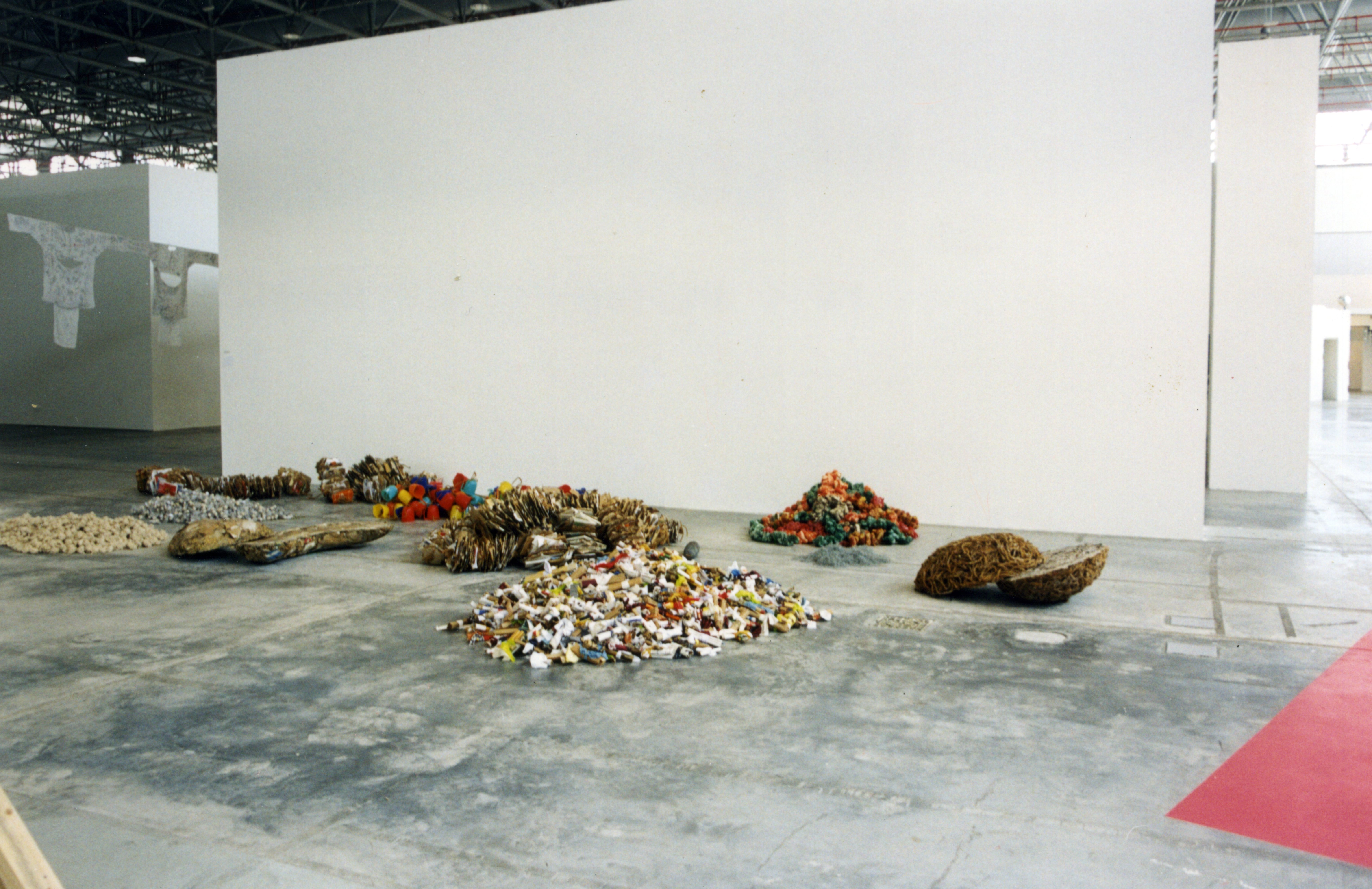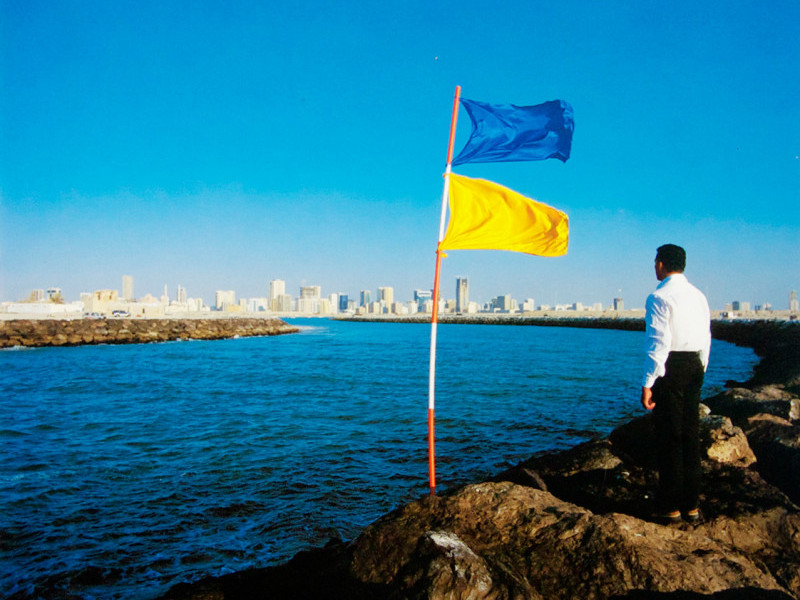
Selected Works, 2003
Hassan Sharif
Selected Works, 2003
Installation view
search


Hassan Sharif
Selected Works, 2003
Installation view
The New Art Space in a Changing Reality: On Hassan Sharif.
The beginning of the 80's witnessed a general elevation of culture, literature and art in the United Arab Emirates. It was more of a creative elevation with numerous names of novelists, poets, writers and artists, whose voices intermingled with their brothers', the other resident Arabs, who reacted to this creative transformation that the Emirates have not seen since the creation of this modern state. Study abroad, regulation of public education, the founding of the national university and the improvement of political socio-economic relations with the Gulf and the rest of the world have all yielded success and created a balanced equation that put the Emirates on the Arabian and global map, and made it a focal point of all new attempts and ideas, gathering and melting and maturing to create a viable and useful product for the common good.
And don't think that the resistance, give and take, and the heated dialogue that accompanied this new birth was a complete refusal for 'the New' as much as it was a product of the transformation, change and exchange. For cultural constructs are the last stronghold of value change and transformation. Perhaps that's why the new transformation had caused such a huge shake up, and many others, various negative reactions ranging from criticism, to condemnation and complete disapproval, to preserve the old and save the inherited traditions. It comes through the desert like I a rushing tide. Coming with all its unpredictability to unearth and reconfigure the old and Il is a reconfiguration that is contrary to that "new" in the 60's when new voices pierced through ll1~ walls of convention in the cultural and artistic constructs of class - war and activism; when new writings started with a new spirit and signalled a new start for a new era, knocking on the doors to tell about a coming 'coup d'etat'. This performance of the translation of the old/new is not simply of transgression and subversion, but staged in the agonistic and untranslatable ground of differing cultural systems of social and cultural signification. Hassan Sharif's assemblages and found archives speak in-between not as pastiche but as surface. His descriptions are ways of not fixing the work's temporal and discursive formations in the migration of meaning in their sign.
The confrontation between the New and the Old varies between depth and surface. Some treat it deeply and considered it a sign of the well-being of a state of affairs in the Emirates, while oth rs discard it as a fleeting trend and prefer that all vanish in forgetfulness. Within the artistic community itself, some armed themselves with ideas and concepts stolen from the terrain of other histories, and in the hybridity of cultures to yield a sense of cultural belonging; and some rode away with the tide and went with the wind that brings both good and ruin.
In fact some of the artists were oblivious to the translation of the progressivist myths of the modern into the passing moment's agency as freedom of expression and the sense of finding a new cultural corpus - a drive for emergence.
In the field of the arts, we see at a glance the 'New' like a storm that unearths all that is facing it, full of dispute and controversy, this state continues but in an indeterminate or hybrid form.
Breaching the convention of painting was always a violent and bloody event. The shock of the new always has had its aftermath. Its birth is not an explosion of all the challenges and conflicts between the different artistic forms, rather in counter-argument to the ideologies that essentialized the meanings and agency of a reflexive art.
A shift in syntax, pathways through actions, refusals of the fixity of the past as the origination of the future, endurance and continued opening up of existence gives credence and enlightenment: what might/could be, where the artist's time out of repetition, moves us forward, erasing tile compliant past tethered to the myth of progress. This forward movement in Sharif and his disciples is neither teleological, nor is it an endless slippage. Bhabha writes "It is the function of the lag to slow down the linear, progressive time of modernity to reveal its gesture, its tempi, the pauses and stresses of the whole performance achieved by damning the stream of real life."
More than a decade has passed on the "Miraijah" attempt in Sharjah. Hassan Sharif in particular knew over ten years since his return to Sharjah how to cultivate new grounds and to teach (not outside or beyond the re-inscription or re-iteration of the historical Western avant-garde (from Duchamp) but in the very modality and effects of that reinscription in the present). Moving towards a new art, moving in the sense of "the road-less-travelled" is to assume an effective political identity or image, where the limits and conditions of specularity have to be exceeded and erased by the inscription of otherness. As critique contingent with no attention to traditional boundaries and affects, but to move the location of culture from the space of demographic plurality to the negotiations on the borderlines of cultural translation, it damns up the real a intangibl or unrepresentable and, therefore, open.
In the past years, all those (artists) came together through Sharif to create a discourse of the "new" in the reconstituted terms of 20th century thought, that coincide exactly in a present with their contemporary fellow poets, novelists, writers, dramatists, video and film makers and intellectual thinkers.
In the Emirates, what happened during the past decade and a half suggests that "new art", just as "new poetry" and "new novel" and "new film", is developing and shaping producing its own criticism and group-based politics of representation; this non-accidental 'new' is emerging in the differentiated, unheard voices and the asynchronic landscapes of Sharjah. From Hassan Sharif to Hossein Sharif to Mohammed Ahmed Ibrahim to Abdul- Raheem Salem to Mohammed Kazem, for example, we do not witness any repetitive methodology or motivation or relationship as a distinctly tangible common aspect, in any traditional sense of the future as the fixity of the past.
On the other side, one cannot escape that captivating "bond of newness" that all the works of those artists expound. Belonging culturally together, in the "time lag". That intangible aspect evades our common awareness of stereotypes similarity in an opening of "foreign" space, of a complex ambivalence, sifting the sand, to reclaim a scrap, a series of findings in the urban terrain, private histories in rags and remnants diaries and personal memory inscripted onto Duchamp's vanitas, his narcissism.
A new reading of such decaying foreign matter is always to be culturally translated from the vanitas or still-life, we can feel uncertain when we stand before the work of an artist from Egypt or Sudan or England or Bangladesh or Palestine or Holland or Sharjah, of the stereotype, the genre, the fetish, and its splitting of language. Does it translate? Perhaps that's why Hassan Sharif remains influential as from a different subject perspective: nomadic, complementary, not 'split' in opposition, but moving from an unfixed point of view, neither inside or outside, where a purpose for the work of art that is far from mimicking reality or reflecting it or skewing it, rather aiming at sorting emotion from element and intermediating both, breaking down the work of art into "needs" to reach that which is simple and innocent, that "you" a regular person - produce in that new space of the "present" as your continual translation.
The idea precedes all these works culture follows ... the idea of creating a language that is different, enunciated distinctly that overwhelmed by the coloniser, seeks to replace with a poetics of re-location and re-inscription. Those modernist strategies are materially re-located without authorisation from the traditional, purist concept of modern art (it is the modernist's sense of the angst-ambiguity of the moment, and now, as the depersonalising dialectic of the (global) as an unrepresentable newness). That idea was accomplished despite the objections of many, in the sense that the new (fantastic re-namings of this new cultural difference, from modernism contradicts the work of art in that the traditional view of the ontological cast, where differences are effects of some integrated past or future) and the conventional artistic frameworks and methodologies all go out the window in the newness. The fact that the critics misunderstand illustrates the purpose, which completely turns the work's writing/history on its head and upon ours, as if already sewn into its apparatus and fabrication.
Hossein Sharif confuses the observer to provoke action. We even find Mohamed Ahmed Ibrahim taking to heart Piet Mondrian's saying "the more life becomes more balanced the more art shall disappear." From there we can say exactly that these artists interrupt the discourse of modernity through these displacing, interrogative subaltern narratives, as a release from the possession, that requires both the linguistic investiture of the subject and a practice of diasporic metaphorical performance.
What Khalil Abdul-Wahed, Farouq Matar, Salih Jameel, Saeed Nisaery, Abbass Hussein, a Matar Saeed, Mohamed Obeid, Ahmed Sharif, and Hassan Sharif's works do is perform a liminal function. This could be a new experience of the boundary or the non-place (not to be filled) goes someway to keep empty. It is a de-centred perspective that Hassan Sharif presents in "Sharp object to create art" that contests the assumption to secure future history as a time without duration and a space without a moment. Sharif finds a way out of such complicity of spatial fantasies, and erases the dictate of the occidental 'culture of common sense'.
The new art in transformation: to self, to objects could be a renewal as it iterates the split beside the self as the uncanny objects discarded and re-formed without authority.
"When I present threads of cotton or a cut rope of nylon tied to a steel wire I present the object and let it speak for itself"
By so doing the reading of the artist in "Sharp object to create art" is a reflection of Sharif's 'non-modern' self. It is an Emirates' art still struggling in the light, in the collective human sphere, in that it attempts to acquire a right to signification, to interdeterminacy, never singular or in total opposition: a recognition in the disjunctive present.
Maybe through such a reading as Hassan Sharif's treatise concerning his colleagues, that such assertions and confessions concerning the impossibility of "The New" that "newness" which Sharif extends and expands as the present in the space he constructs out of little pieces, is the glimpse of what is becoming ... the "what might have become to what could be now".
PL

Sharjah Biennial 6